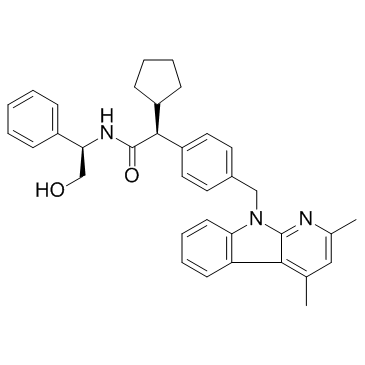| Description |
Implitapide (AEGR 427) is a microsomal triglyceride transfer protein (MTP) inhibitor.
|
| Related Catalog |
|
| Target |
MTP[1]
|
| In Vitro |
Implitapide suppresses MTP activity using a recombinant human form complexed with protein disulphide isomerase (IC50=10 nM) and inhibit secretion of apoB-containing very low-density lipoprotein (VLDL)-like lipoproteins from a human hepatoma cell (HepG2) with an IC50 value of 1.1 nM[1].
|
| In Vivo |
Implitapide (3.2 mg/kg/d) significantly reduces the plasma lipid levels to nearly or below the chow diet (CD) level at 4 and 8 weeks of treatment (p<0.01). Implitapide (3.2 mg/kg/d) markedly suppresses lipid-stained lesions in the mice fed the western-type diet (WD). Implitapide (3.2 mg/kg/d) significantly decreases lesion area by 83% compared with that of the WD group (p<0.01). ApoE KO mice fed a WD containing Implitapide (1, 5, and 15 mg/kg/d) for 14 weeks have been shown to reduce significantly both plaque area (by 66, 78, and 93%, respectively) and lipid moieties within plaque (4.3, 2.6, and 0%, respectively, versus 9.5% in controls). Implitapide at a dosage of approximately 3.2 mg/kg/d significantly reduces the lipid-stained aortic lesions by 83% in apoE KO mice[1].
|
| Animal Admin |
Mice[1] Male apoE KO mice aged 6 weeks are fed either the CD or the WD. At age 7 weeks, apoE KO mice fed the WD are divided into two groups with similar mean body weight: apoE KO mice fed the WD and apoE KO mice fed the WD containing Implitapide (WI). Age-matched C57BL/6J mice fed the CD are used as a naive control (C57BL). Implitapide concentrations (14-22 ppm) in the diet are adjusted once a week to ensure dosage consumption of approximately 3.2 mg/kg/d. Body weight and average food consumption for 3 d are monitored weekly. Before and at 4 and 8 weeks of treatment, blood is collected for measurements of plasma lipid levels. At the 4th week, an oral fat-loading test is performed. At the 5th week of treatment, feces are collected for determination of fecal fat. At the end of 8 weeks of treatment, mice are euthanized for analysis of atherosclerotic lesions[1].
|
| References |
[1]. Ueshima K, et al. Implitapide, a microsomal triglyceride transfer protein inhibitor, reduces progression of atherosclerosis in apolipoprotein E knockout mice fed a Western-type diet: involvement of the inhibition of postprandial triglyceride elevation. Biol Pharm Bull. 2005 Feb;28(2):247-52.
|
